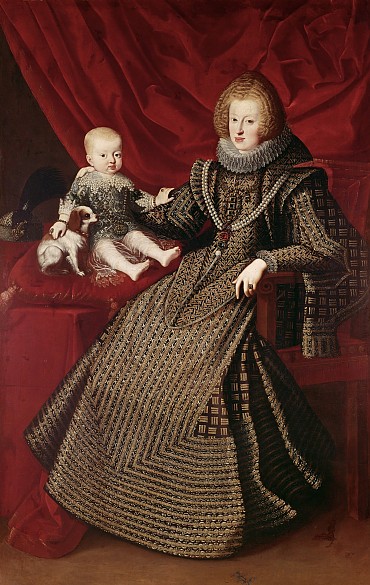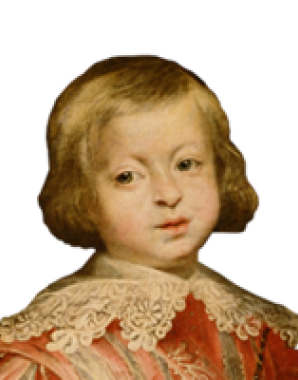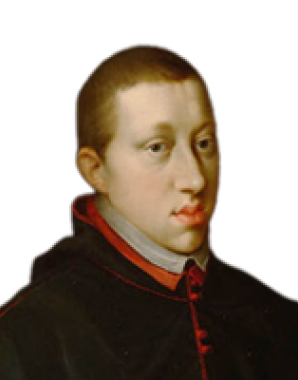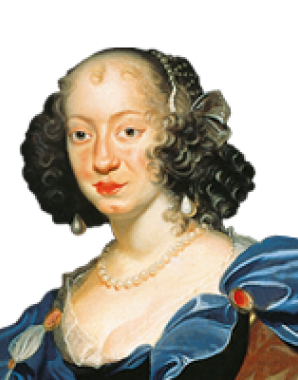Ferdinand III: marriage and offspring
Ferdinand is said to have been a model husband and father. Evidently his Jesuit tutors had successfully inculcated him with the Catholic version of the ideal image of a virtuous prince and faithful pater familias. Ambassadors’ reports relate that the emperor’s marriage was harmonious.
Ferdinand’s first wife was the infanta Maria Anna of Spain (1606–1646), a daughter of King Philip III of Spain and Archduchess Margarete of Inner Austria, one of Ferdinand’s aunts. The marriage was thus another link in the confusing chain of unions within the complicated family nexus of the Spanish and Austrian Habsburgs.
Originally Maria Anna had been intended for Ferdinand’s elder brother Johann Karl, but after the latter’s early death in 1619 Ferdinand assumed the status not only of crown prince but also of the prospective bridegroom of the Spanish princess. Although he was accepted in principle, lengthy negotiations were to follow. In order to satisfy Spain’s requirements Ferdinand also had to bear a royal title. This hurdle was overcome when he was elected king of Hungary in 1625 while his father was still alive. The official betrothal took place in 1626 but was followed by further delays since the amount of the bride’s dowry and the composition of their household became political issues. In 1629 the infanta finally set out on her wedding journey to Vienna, which was to take fourteen months due to the threat of war, epidemics and not least delaying tactics on Spain’s part. The wedding eventually took place in Vienna in 1631 and was an elaborately staged spectacle intended to make people forget the travails of war.
Evidently the old saw that good times come to those who wait proved well-founded in this case, as the couple’s life together was marked by affection and trust. Maria Anna became an important source of support for Ferdinand and even acted as his representative when he was absent.
The marriage resulted in six children:
The first-born son Ferdinand (b. 1631), who was systematically groomed as his father’s successor, died of smallpox at the age of twenty-one.
Yet another connection with the Spanish line of the dynasty was created when Maria Anna (b. 1634) was married to King Philip IV of Spain, who was her mother’s brother.
Two sons who died in infancy were followed by the birth of Leopold (1640), who was to succeed his father as ruler.
Maria Anna’s last pregnancy was to prove fatal: in 1646 she died in the later stages of pregnancy, probably from pre-eclampsia. The premature infant, a girl, who was born by Caesarean section immediately after her mother’s death, survived only briefly and was buried together with her mother.
Two years later in 1648, Ferdinand married for a second time. His bride was again a close relative but this time from the Austrian side of the family. Archduchess Maria Leopoldine (1632–1649) was the daughter of Ferdinand’s uncle, Archduke Leopold V, the head of the collateral Tyrolean branch of the Habsburgs, and Claudia de Medici. However the young woman died only thirteen months later following the birth of her first child, Archduke Karl Joseph.
As a later-born son, the young prince Karl Joseph was destined for a career in the Church. At the age of only thirteen he became the prospective candidate for the office of the Grand Master of the Teutonic Knights as successor to his uncle, Archduke Leopold Wilhelm. He was also intended to assume the latter’s offices as bishop of Passau, Olmütz and Breslau, all richly endowed livings. Karl Joseph was also being considered as a candidate for the post of Stadtholder or governor of the Spanish Netherlands. However, before he was able to take up any of these posts, the prospective prince of the Church died in 1664 at the age of only fifteen.
Ferdinand’s third marriage, to the Italian princess Eleonora of Gonzaga-Nevers, daughter of the duke of Mantua (1630–1686) and twenty-two years his junior, took place in 1651. Eleonora was to outlive her husband by almost three decades.
During the six years of their marriage she gave birth to four children, of whom only two daughters survived:
Eleonora Maria Josepha (1653–1697) was married in 1670 to King Michael of Poland, who reigned only briefly. She was released from what had proved to be a difficult union by the death of her husband in 1673. In 1678 she remarried, her second husband being Duke Charles V of Lorraine. Eleonora is thus the grandmother of Franz Stephan of Lorraine.
Maria Anna Josepha (1654–1689) was married to the Elector Johann Wilhelm of Palatinate-Neuburg in 1678. The Catholic dynasty of Palatinate-Neuburg was at that time an important ally of the Habsburgs within the Empire and was enjoying a stellar advancement in its status. The daughters of the family were systematically married off to members of the Habsburg family clan; in 1676 one of the elector’s sisters, Eleonore, had married Ferdinand’s son and successor, Emperor Leopold I. In 1690 another sister, Maria Anna of Palatinate-Neuburg, was to marry the last Habsburg on the Spanish throne, King Charles II.

















